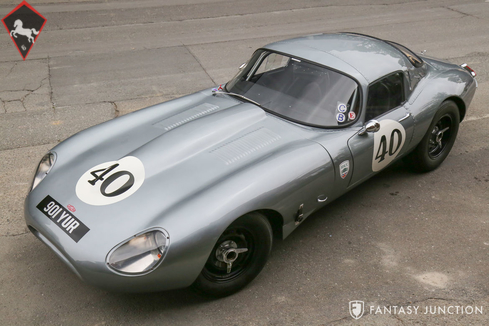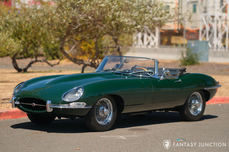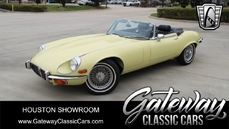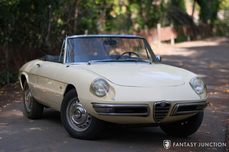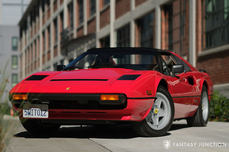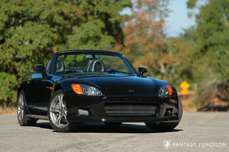Jaguar E-type 3.8L Inline 6-Cylinder Dry Sump 1962
Allmän beskrivning :
1962 Jaguar E-Type Series 1 “Low Drag” Coupe
s/n 887033, Engine No. ZA7747-8
Silver with Black Leather
Consistently ranked today as among the most beautiful sports cars ever conceived, the Jaguar E-Type was simply a revelation of beauty and performance on the day it was unveiled at the 1961 Geneva Motor Show. Brilliantly designed and offering unrivaled race-bred performance, the E-Type became an instant sensation with enthusiasts all over the world. With its beautiful lines and surprisingly affordable price, the E-Type grew to iconic status where it still reigns, continuing to charm new generations of enthusiasts. But it wasn’t beauty alone. Jaguar’s racing experience delivered very progressive performance features to their surprisingly affordable car, including independent front and rear suspension, disc brakes all around (inboard at the rear to reduce unsprung weight), and Jaguar’s legendary twin-cam inline six-cylinder engine.
During the first year of production, Series 1 E-Types were assembled by the thousands to meet unprecedented customer demand, while Jaguar investigated derivatives of the model specifically for racing purposes; the most stunning of which was the 1962 Low Drag Coupe. Built in the spirit of the iconic D-Type, with a closed coupe configuration, the standard E-Type received a modified the windscreen angle, new roofline, and a welded rear hatch shut. The following year, the Lightweight E-Type variant was constructed, this time as an open car. These cars experienced some racing success in private hands, with one car specifically constructed for high speed Le Mans duty (known as the “Linder/Nocker” car), but tragically was severely damaged in testing, and another (known as the “Samir 49 FXN” car) constructed in period, which performed admirably at Le Mans and other racing venues. Regarded as one of the finest examples of motorsports excellence from this period, rare and original Low Drag Coupes sit prominently in the league of the Ferrari GTO, Cobra Daytona, and other superlative racing cars from the Golden Age of Motorsports.
This particular recreation was constructed under commission by Jacob Engineering, UK. A world class racing and performance firm founded by proprietor and expert Jaguar restoration specialist Mark Davis, Jacob Engineering specifically undertook the build intent on designing and constructing the finest recreation; one that would emulate the famous 1963 car that engineer Dr. Samir Klat (then a young but talented mechanical engineer studying at Imperial College) developed with amateur drivers Peter Lumsden and Peter Sargent. The original car, known as “49 FXN”, was built in 1963 and campaigned in many 1964 races with some success. The car received ongoing development modifications including air flow tests with wind tufts on the body surface and chassis improvements. The difference in the body changes resulted in significant improvement yielding a 174 mph speed achieved on the Mulsanne Straight and positioning in third place at one point behind a Cobra Daytona at the 1964 Le Mans 24 hours. More typically emulated Low Drag Coupes seldom reflect the unique body design of the Samir 49 FXN.
To begin the build, the commissioning owner elected to emulate 49 FXN in part because of its unique visual features. The team began construction with a carefully selected donor car. According to the Jaguar Heritage Trust Certificate included with the accompanying documentation, an original Jaguar Series 1 E-Type FHC, finished in Carmen Red and trimmed with black interior was completed September 27, 1962 and dispatched to Jaguar Cars, New York October 9, 1962. Having served an appropriate life as a road car, chassis #887033 was selected as an ideal candidate for conversion to the Low Drag configuration. In addition to the origin as a factory Jaguar, it further offered the proper 1962 designation as ideal factory construction for the basis of the build. Utilizing the steel subframe and main center section, virtually all of the production steel body was removed, and hand-crafted alloy body panels fabricated for fitting.
During the construction Jacob Engineering worked closely with the very best teams of people including alloy body panel specialist Rod Jay, engine work by Scholar Engineering, and numerous world class racing and Jaguar specialty parts vendors for performance components. Construction took approximately two years with Mark Davis personally restoring the original steel tub and Rod Jay constructing the gorgeous one-piece aluminum bonnet, in keeping with the original factory cars. According to documentation on file, Scholar Engineering built the balanced and lightened 375hp engine with Carrillo rods, Venolia forged racing pistons, correct triple Weber 45DCOE carburetors, and a correct dry sump oil system. John Arnold of Revival Motorsport built the 4 speed all synchromesh gearbox fitted with a Salisbury 3.77:1 Power-Lok limited slip differential, and Dunlop brakes stationed at all four corners. Throughout the build process, attention to detail continued not only with the exterior details but in the interior construction as well. A correctly specified Appendix K roll cage was installed to meet FIA requirements along with period style racing bucket seats and full racing harnesses. Photographs and documentation accompanying the car offer validate the build of the design and mechanical features of this unique build.
Paying close attention to the distinctive design achieved by Dr. Klat and his 1963 aerodynamic wind tests, the resultant car was completed to a very high standard and made available for use by 2013. The commissioning owner specifically indicated the car was to be built for race use with a careful eye to meet FIA requirements. As such, the car is accompanied by FIA papers, but can also be used as a road car with State of Arizona title and valid road registration. The current owner is a respected racing enthusiast with a history of multiple performance vehicles for both racing and personal enjoyment. In 2016 he set the fastest national time in a JCNA autocross event.
Today this beautifully finished Low Drag Coupe features high gloss paint with a deep finish and excellent cosmetics showing only mild areas of use. The cosmetic condition is much higher quality than typically seen race cars with such distinguished performance history. Certainly, a purpose-built racer, the look and feel of the overall design is both dramatic and captivating. The alloy coachwork has been crafted with care to replicate the original 49 FXN body design, thoughtful details, and particularly the striking uniquely tapered coupe roofline, and tightly refined tail. Literally every surface has been constructed with consistency to the Samir Klat design. Panel fit is quite good throughout, especially considering the light construction of the alloy body panels and aircraft inspired exposed-rivet construction. The lighting, lenses, plexiglass and glass appear very clean and preserved throughout. The carefully delineated overlapping body seams punctuated by the rivet details deliver a purposeful yet powerful contrast to the fluid lines. The recessed Le Mans fuel filler, side bonnet latches, and other handmade features offer visual delight at every corner. Both the front and rear of the body have been constructed without bumpers or further heavy production details, relying on only the slightest of protection with the thinly covered headlamps. The solid slotted wheels are accented with “triple eared” knock-offs giving the car great stance on appropriately sized Avon tires.
The interior is all business with typical racing gear, FIA approved roll bar, racing seats, and proper Willans safety harnesses. Stepping into the cockpit takes some adjustment as the interior capacity will challenge drivers of larger stature. However, once inside, the controls are easily accessible and critically arrayed. The vintage inspired seats offer good comfort and support while the dash and instruments are well laid out. Often race cars can be rather spartan or reply on an unfinished aesthetic. Not so with this example as it offers carpeted floor, covered door panels, and seating for a fortunate passenger. The interior door panels and other interior trim are consistent in finish and texture to the other materials completing the cockpit. The interior conveys an honest and harmonious look and feel, very much in keeping with the visual goals of the exterior. Raising the trunk lid, clarity of purpose is revealed in the details, including the careful lightening of the telescoping trunk support rod. The trunk capacity is nominal but contains the critical fire suppression system canister which is plumbed throughout the car. The cast aluminum fuel tank filler exits through the trunk lid.
The engine and engine compartment offer excellent visual appearance with proper detailing and finishes beyond those typically seen in race cars. Here too there is ample evidence of handmade items blended with celebrated Jaguar features including polished aluminum castings for the cam covers, polished air horns breathing into triple Webers, and once again, aircraft inspired riveting surrounding the cowl where the windshield joins the body. The undercarriage reveals yet another dimension of excellence with attention to mechanical details, excellent finishes and coatings, and obvious cosmetic care. Other details include handmade dual snorkel inboard brake cooling ducts, stainless steel exhaust, and top-level fittings and hardware. Here again the build quality is not merely devoted to the design of the body to simply emulate the Low Drag Coupe. The entire car has been thoroughly and thoughtfully engineered to deliver a superbly performing race car in every respect.
The car is accompanied by a pair of upholstered, form-fitting “poured” bead seats for both driver and passenger, a notebook of documents including a copy of the Jaguar Heritage Trust Certificate, copies of FIA paperwork, former ownership paperwork, and various build documents outlining much of the work performed on the car during construction.
Rarely does such an exemplary recreation of a rare and unique car come to market. The superlative construction, engineering, and handmade features of this 1962 Jaguar Low Drag Coupe truly set it apart from other examples. Built specifically to honor the one of a kind Dr. Samir Klat “49 FXN” example, this is an excellent opportunity to acquire a remarkable racecar that can be driven on the road or prepared for tours, events, or competitive vintage racing. The beautiful and legendary E-type design enhanced by the history and unique Low Drag Coupe body design offers the next fortunate owner an immediately rewarding driving experience, be it on the grid or driving on the open roadways.
https://fantasyjunction.com/inventory/1962-jaguar-e-type-low-drag-recreation-by-jacob-engineering/overview
1962 Jaguar E-type 3.8L Inline 6-Cylinder Dry Sump is listed såld on ClassicDigest in Emeryville by Fantasy Junction for $259500.
Fakta i bilen
Karosstyp : Personbil Märke : Jaguar Modell : E-type Modellversion : 3.8L Inline 6-Cylinder Dry Sump Motorvolym : 3.8 Årsmodell : 1962 Läge : Emeryville Fordon Registrering : Normal
Såld
Information om säljaren
Såld
People who viewed this Jaguar E-type also viewed similar Jaguar listed at ClassicDigest
Other cars listed for sale by this dealer
om Jaguar
Åh, historien om Jaguar, från dess tidiga dagar som SS Cars Ltd. till sin höjdpunkt med D-typen och gatubilsevolutionen i form av den ikoniska E-typen. Det finns något alldeles brittiskt över denna berättelse, och jag ska berätta den som en brittisk journalist skulle göra.
I början:
Vår resa in i Jaguar-världen börjar på 1930-talet, när ett företag som kallades SS Cars Ltd. dök upp. Trots den olyckliga sammanträffandet av deras initialer med de stigande politiska spänningarna i Europa började de producera stilfulla och prestandainriktade bilar. SS 100, som introducerades 1936, var en symbol för elegans och hastighet och lade grunden för vad som skulle bli Jaguar.
Jaguars födelse:
När skuggan av andra världskriget närmade sig beslutade SS Cars Ltd. klokt att distansera sig från SS-initialerna. Så 1945 blev de officiellt Jaguar Cars Ltd., ett namn som snart skulle bli synonymt med brittisk lyx och prestanda.
XK-serien:
Jaguars efterkrigstid gav oss XK 120, en verklig sensation 1948. Med sin strömlinjeformade design och en kraftfull 3,4-liters raksexmoters blev den världens snabbaste seriebil. XK 120 var ritningen för det som komma skulle - Jaguar som förenade stil med hastighet på ett unikt brittiskt sätt.
D-typens dominans:
Sedan kom D-typen, en sann racinglegend. Introducerad 1954, vann den Le Mans tre gånger på 1950-talet och visade Jaguars tekniska skicklighet. Med sin innovativa monokokkonstruktion och den ikoniska fenan bak var D-typen höjdpunkten av Jaguars framgång inom motorsport.
E-typens framträdande:
Men den verkliga vändpunkten kom 1961 med introduktionen av E-typen, ofta beskriven av Enzo Ferrari som "den vackraste bilen som någonsin byggts". Dess långa motorhuv, böljande kaross och en 3,8-liters motor som levererade upphetsande prestanda gjorde den till en omedelbar klassiker. E-typen var inte bara en bil; den var ett konstverk på hjul och kunde nå 150 mph på vägen.
Gata och racingsuccé:
E-typens skönhet matchades av dess förmåga på racerbanan. De lätta E-typarna var särskilt framgångsrika i olika racingevenemang och cementerade Jaguars rykte som en kraft att räkna med inom motorsport.
Raffinemangets ålder:
När vi fördjupar oss i Jaguar-historien finner vi att 1950-talet och 1960-talet var en tid av raffinering och expansion. Tillsammans med den magnifika D-typen och den ikoniska E-typens framträdande introducerade Jaguar modeller som ytterligare befäste sitt rykte för lyx och prestanda.
MK2:
I slutet av 1950-talet presenterade Jaguar MK2, en sportig sedan som kombinerade elegans med kraft. Denna eleganta fyradörrars salong var en favorit bland bankrånare och polisen, tack vare dess exceptionella hastighet och hantering. MK2 var en symbol för Jaguars förmåga att förena sofistikering med prestanda och hade också en framgångsrik racingkarriär.
XJ6:
Hoppa fram till 1968 och Jaguar lanserade en bil som skulle definiera lyxbilar i decennier framöver - XJ6. Det var ett mästerverk i teknik och design med en jämn raksexmoters, oberoende bakre fjädring och en rymlig, vackert inredd interiör. XJ6 var en symbol för brittisk elegans och erbjöd en så smidig åktur att det kändes som om den gled över vägen. Den blev flaggskeppsmodellen för Jaguar och satte standarden för lyxbilar och visade en nivå av raffinering som imponerade på konkurrenterna.
Blandningen av klassiskt och modernt:
Medan MK2 och XJ6 representerade utvecklingen av Jaguars sedanmodeller, bibehöll de märkets engagemang för prestanda och lyx. Dessa bilar hörde inte bara hemma på racerbanan; de trivdes lika bra på de stora boulevarderna som på en avslappnad körning genom den engelska landsbygden.
Utmaningarna av förändring:
Men när 1970-talet närmade sig, ställdes Jaguar, liksom många brittiska biltillverkare, inför ekonomiska utmaningar och ägarförändringar. British Leyland-eran förde både möjligheter och svårigheter med sig när varumärket navigerade genom olika sammanslagningar och övergångar.
Ändå fortsätter arvet från MK2 och XJ6, tillsammans med D-typen och E-typen, att definiera Jaguar som en tillverkare som förenar tidlös elegans med en anda av prestanda. Dessa klassiska modeller, vare sig de körs på slingrande vägar eller står som samlarföremål, tjänar som ett vittnesbörd om Jaguars långvariga närvaro inom den automobila exklens värld.
Jaguar-historien, från dess tidiga dagar som SS Cars Ltd. till skapandet av ikoner som E-typen, MK2 och XJ6, är en resa som speglar essensen av brittisk bilkultur - en blandning av lyx, kraft och stil som fortsätter att fängsla entusiaster och samlare över hela världen.
